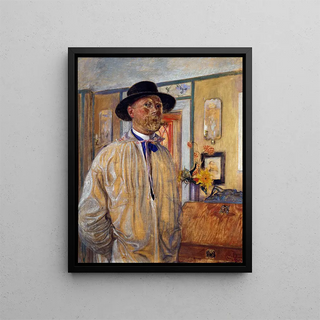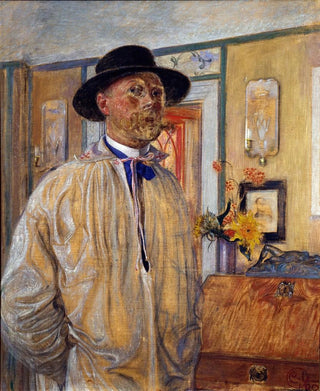Art print | Self-portrait - Carl Larsson


View from behind

Frame (optional)
Autoportrait Art print - Carl Larsson – Captivating introduction
Carl Larsson's self-portrait is an iconic work that transcends mere exercise in personal representation to become a true ode to introspection and creativity. Created by a Swedish artist whose name is synonymous with Scandinavian art at the end of the 19th century, this art print serves as a mirror to the artist's soul, an exploration of his identity and universe. In this piece, Larsson invites us to delve into his inner world, while offering a glimpse into the artistic life of his time. The art print of this work not only allows appreciation of the artist's technique but also enables us to feel the emotion emanating from each brushstroke.
Style and uniqueness of the work
The self-portrait stands out for its unique style that combines realism and impressionism. Larsson uses a delicate color palette, blending soft and luminous tones that infuse a warm atmosphere into the piece. Light plays a central role, illuminating the artist's face while creating subtle shadows that add depth to his depiction. This choice of colors, combined with meticulous attention to detail, demonstrates undeniable technical mastery. The background, often neglected in other self-portraits, is here carefully crafted, enriching the visual narrative and placing the artist in a context that evokes his intimate environment. Larsson thus manages to capture not only his appearance but also his essence, making this work a centerpiece of his artistic journey.
The artist and his influence
Carl Larsson, born in 1853 in Stockholm, is one of the most emblematic figures of Swedish art. His work is deeply rooted in the Art Nouveau movement, but he also incorporated influences from the Pre-Raphaelite movement and Japonism, which marked his era. Larsson does not merely paint; he creates visual stories that celebrate everyday life, nature, and family. Through his works, he captured the spirit of the Swedish home, giving voice to themes such as love, tenderness, and the beauty of simple moments. His influence extends

Matte finish

View from behind

Frame (optional)
Autoportrait Art print - Carl Larsson – Captivating introduction
Carl Larsson's self-portrait is an iconic work that transcends mere exercise in personal representation to become a true ode to introspection and creativity. Created by a Swedish artist whose name is synonymous with Scandinavian art at the end of the 19th century, this art print serves as a mirror to the artist's soul, an exploration of his identity and universe. In this piece, Larsson invites us to delve into his inner world, while offering a glimpse into the artistic life of his time. The art print of this work not only allows appreciation of the artist's technique but also enables us to feel the emotion emanating from each brushstroke.
Style and uniqueness of the work
The self-portrait stands out for its unique style that combines realism and impressionism. Larsson uses a delicate color palette, blending soft and luminous tones that infuse a warm atmosphere into the piece. Light plays a central role, illuminating the artist's face while creating subtle shadows that add depth to his depiction. This choice of colors, combined with meticulous attention to detail, demonstrates undeniable technical mastery. The background, often neglected in other self-portraits, is here carefully crafted, enriching the visual narrative and placing the artist in a context that evokes his intimate environment. Larsson thus manages to capture not only his appearance but also his essence, making this work a centerpiece of his artistic journey.
The artist and his influence
Carl Larsson, born in 1853 in Stockholm, is one of the most emblematic figures of Swedish art. His work is deeply rooted in the Art Nouveau movement, but he also incorporated influences from the Pre-Raphaelite movement and Japonism, which marked his era. Larsson does not merely paint; he creates visual stories that celebrate everyday life, nature, and family. Through his works, he captured the spirit of the Swedish home, giving voice to themes such as love, tenderness, and the beauty of simple moments. His influence extends






